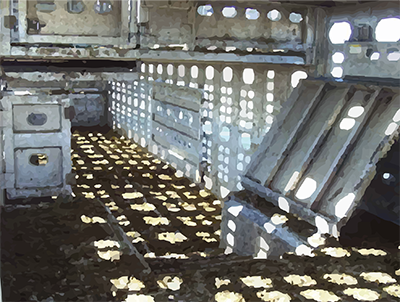InTrans / Aug 26, 2015
Animals abroad: How did the livestock cross the road?
Go! Magazine
 posted on August 26, 2015
posted on August 26, 2015
America is a nation of beef eaters, and, well, there are chicken eaters too. Really, there are plenty of everything eaters. You may travel to the local supermarket to get your weekly supply of meats, but how does it get there? Livestock, specifically cattle, swine, and chickens often have a long journey ahead of them:often by heavy truck or train. In this article, to better understand how animals travel, let’s take a look at how some of the most traveled animals:livestock:get safely from place-to-place.
The 28 Hour Law
In the late 1800s, livestock were often shipped across the country with little food or water in overcrowded train cars. As a result, many animals died in transit:as many as 900 cattle often died in one train car during the 1870s.

The transporting of livestock has been around for centuries. However, it wasn’t until the late 1800s that rules were put into place to protect livestock from unnecessary stress, injury, and even fatality. In response to the inhumane treatment of livestock, the American Humane Association (AHA) and local divisions of the Society for the Prevention of Cruelty to Animals (SPCA) collaborated. The result? A law called the “28 Hour Law”? was first enacted in 1873, which required the humane transport of livestock, specifically the rail transport of cattle, sheep, swine, and other animals. It was amended in 1994 to include transportation by express or common carriers involving confinement in a “vehicle or vessel.”?
In response to a legal petition from the Humane Society of the United States (HSUS), the U.S. Department of Agriculture (USDA) agreed in September 2006 that the term “vehicle”? applied to trucks and other common forms of transportation. The 28 Hour Law states that animals shall “be unloaded in a humane way into pens equipped for feeding, water, and rest for at least five consecutive hours.” Although much progress has been made in the care and transport of livestock since the late 1800s, the 28 Hour Law doesn’t cover everything. For more information on the law, visit the USDA National Agricultural Library.
First class or coach?
Remember, it wasn’t until 2007 that the USDA named “trucks”? as livestock transport vehicles, which means that for 134 years truck drivers didn’t have to abide by the 28 Hour Law. That year was indeed a monumental time, because trucks are one of the main carriers of livestock and the one most often seen across America.

Although the percentages are unclear, pigs are especially known to travel best by truck. Heavy trucks with ventilation holes are used to transport pigs during hot weather. Often equipped with hoses leading into the vehicle, the pigs are sprayed with a coarse spray and then the water is turned off for the animals to cool by evaporation. Many other animals, such as goats, chicken, and cattle, are also known to travel frequently by truck.
The important thing that people trucking and handling animals need to remember is that wind chill and heat causes a lot of stress on livestock, which can have fatal consequences. The transportation vehicle used needs to be taken into consideration. Wetting the hair coat on cattle destroys its ability to insulate the animal’s body. Death losses in cattle are often greatest when the temperatures are near freezing and either rain or freezing rain blows into the truck. With an estimated nine billion livestock transported every year in the US alone, safe and humane transportation is very important.
The right route
There is no doubt that the unloading and re-loading of thousands of animals every 28 hours is a huge pain and problem for truck drivers and handlers. And then there is the potential problem of disease contamination when the animals are allowed to roam, abet in a remote area, while unloaded. However, the 28 Hour Law continues to be upheld today, because it has greatly reduced the number of livestock fatalities nationally while (hopefully) reducing the stresses of travel on the animals. Just like human travel, animal travel is just as important. It is important to take preventive measures to reduce injuries and fatalities while traveling. With livestock traveling an average of 1,000 miles in their lifetime, or about a 16 hour drive by truck, rest breaks can be a huge advantage for livestock and producers. These regulations enacted by the 28 Hour Law support and protect the lives of livestock and encourage strict precautions by livestock drivers and handlers.
By Jackie Nester, Go! Staff Writer